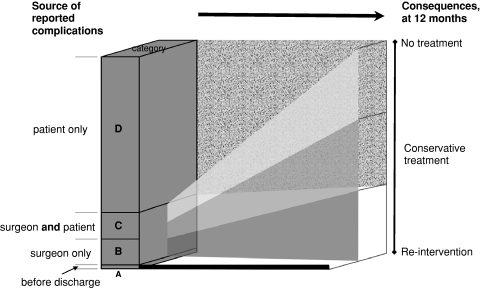Fig. 2.
Source of the reported complications and their consequences after 12 months. (A) Complication arises before discharge and requires re-intervention, but the patient is unaware of a problem (e.g. a screw is too long and carries the risk of erosion of a vessel, or a screw is malpositioned, increasing the risk of instability). These complications carry a risk for the future and must be acted on early. They arise in approximately 1.4% of all operations (and constitute one-third of all the complications reported at discharge). (B) Complication recorded within 12 months by the surgeon but not by the patient may concern something like a screw penetrating the pedicle. This type of complication may or may not lead to an action (often very surgeon-dependent). Occurs in about 4–5% of all patients and comprises approximately half of all the surgeon-rated complications. (C) Complication reported within 12 months by both the patient [= 14% of all patient-reported complications (C/C + D)] and the doctor (= 50% of all surgeon-reported complications (C/C + B) may or may not need treatment. This type arises in 4–5% of all cases. From groups B and C together (i.e. all surgeon-reported complications), about one-third of patients are re-operated, one-third treated conservatively, and one-third not treated at all. (D) Complication reported (up to 12 months) by the patient but not the surgeon. Sometimes treatable and treated conservatively, sometimes not. Such complications are reported by approximately 25% patients

